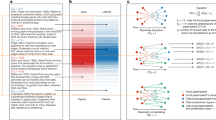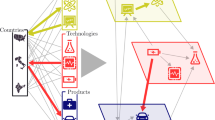Abstract
Quantifying the dynamics of research activities is of considerable current interest, not least because of recent changes in research and development (R&D) funding1,2,3,4,5,6,7,8,9. Here we quantify and analyse university research activities, and compare their growth dynamics with those of business firms10,11,12,13,14. Our study involves the analysis of five distinct databases, the largest of which is a National Science Foundation database of the R&D expenditures in science and engineering for a 17-year period (1979–95) in 719 United States universities. We find that the distribution of growth rates displays a ‘universal’ form that does not depend on the size of the university or on the measure of size used; and the width of this distribution decays with size as a power law. These findings are quantitatively similar to those of business firms10,11,12,13,14, and so are consistent with the hypothesis that the growth dynamics of complex organizations are governed by universal mechanisms. One possible explanation for these similarities is that the combination of peer review and government direction leads to an outcome similar to that induced by market forces (where the analogues of peer review and government direction are, respectively, consumer evaluation and product regulation).
This is a preview of subscription content, access via your institution
Access options
Subscribe to this journal
Receive 51 print issues and online access
$199.00 per year
only $3.90 per issue
Buy this article
- Purchase on Springer Link
- Instant access to full article PDF
Prices may be subject to local taxes which are calculated during checkout



Similar content being viewed by others
References
Moed, H. F., Luwel, M., Houben, J. A., Van Den Berghe, H. & Spruyt, E. Funding and research performance. Nature 392, 119 (1997).
Miflin, B. Institutes top UK science league table. Nature 390, 12 (1997).
Buffetaut, E. No independence for French researchers. Nature 392, 542 (1998).
Anderson, C. Job security—Tenure, under fire once again, still holds strong. Science 265, 1923 (1994).
Holden, C. Tenure turmoil sparks reforms. Science 276, 24–26 (1997).
Halpern, J. J. & Velleman, P. F. Tenure tracking. Science 276, 1321 (1997).
Geissman, J. W.et al. Tenure tracking. Science 276, 1320–1321 (1997).
Gazzaniga, M. S. How to change the university. Science 282, 237 (1998).
Cooper, W. E. Restructuring the university. Science 282, 1047 (1998).
Gibrat, R. Les Inégalités Economiques (Sirey, Paris, (1931).
Ijiri, Y. & Simon, H. A. Skew Distributions and the Sizes of Business Firms (North Holland, Amsterdam, (1977).
Sutton, J. Gibrat's legacy. J. Econ. Lit. 35, 40–59 (1997).
Stanley, M. H. R.et al. Scaling behaviour in the growth of companies. Nature 379, 804–806 (1996).
Takayasu, H. & Okuyama, K. Country dependence on company size distributions and a numerical model based on competition and cooperation. Fractals 6, 67–79 (1998).
Vicsek, T. Fractal Growth Phenomena 2nd edn (World Scientific, Singapore, (1992).
Bunde, A. & Havlin, S. Fractals and Disordered Systems (Springer, Berlin, (1991).
National Science Foundation, DivisionofScienceResourcesStudie Academic Research and Development Expenditures (NSF, Arlington, Virginia, (1998).
Braun, T. & Schubert, A. Indicators of research output in the sciences for 5 central European countries. Scientometrics 36, 145–165 (1996).
Lewison, G. New bibliometric techniques for the evaluation of medical schools. Scientometrics 41, 5–16 (1998).
Schwarz, A. W., Schwarz, S. & Tijssen, R. J. W. Research and research impact of a technical univeristy—A bibliometric study. Scientometrics 41, 371–388 (1998).
United States University Science Indicators on Diskette, 1981–1997 (Inst. for Scientific Information, Philadelphia, (1998).
Narin, F. Patents as indicators for the evaluation of industrial research output. Scientometrics 34, 489–496 (1995).
United States Patent and Trademarks Office Databases 1976–1997 〈http://www.uspto.gov〉.
Higher Education Funding Council for England The 1996 Research Assessment Exercise (HEFCE, Bristo, (1996).
Natural Sciences and Engineering Research Council of Canada NSERC Grant Database for 1991–1998 (NSERC, Ottaw, (1999).
Summers, R. & Heston, A. The Penn World Tables (Mark 5): An expanded set of international comparisons, 1950–1988. Q. J. Econ. 106, 327–368 (1991).
Durlauf, S. N. On the convergence and divergence of growth rates. Econ. J. 106, 1016–1018 (1996).
Lee, Y., Amaral, L. A. N., Canning, D., Meyer, M. & Stanley, H. E. Universal features in the growth dynamics of complex organizations. Phys. Lev. Lett. 81, 3275–3278 (1998).
Amaral, L. A. N., Buldyrev, S. V., Havlin, S., Salinger, M. A. & Stanley, H. E. Power law scaling for a system of interacting units with complex internal structure. Phys. Rev. Lett. 80, 1385–1388 (1998).
Jovanovic, B. The diversification of production. Brookings Pap. Econ. Activity: Microeconomics (1) 197–247 (1993).
Acknowledgements
We thank M. Barthélemy, S. V. Buldyrev, D. Canning, X. Gabaix, S. Havlin, P. Ch. Ivanov, H. Kallabis, Y. Lee and B. Roehner for discussions. We also thank N. Bayers, E. Garfield, and especially R. E. Hudson for help with obtaining the ISI database, and H. F. Moed for comments on the manuscript, and in particular for suggesting the arguments about effectiveness used in the last paragraph. This work was supported by the NSF. L.A.N.A. thanks FCT/Portugal for support.
Author information
Authors and Affiliations
Corresponding author
Rights and permissions
About this article
Cite this article
Plerou, V., Amaral, L., Gopikrishnan, P. et al. Similarities between the growth dynamics of university research and of competitive economic activities. Nature 400, 433–437 (1999). https://doi.org/10.1038/22719
Received:
Accepted:
Issue Date:
DOI: https://doi.org/10.1038/22719
This article is cited by
-
Macroecological dynamics of gut microbiota
Nature Microbiology (2020)
-
Generalised Central Limit Theorems for Growth Rate Distribution of Complex Systems
Journal of Statistical Physics (2014)
-
A coevolving model based on preferential triadic closure for social media networks
Scientific Reports (2013)
-
Statistical Laws Governing Fluctuations in Word Use from Word Birth to Word Death
Scientific Reports (2012)
-
The growth of science and database coverage
Scientometrics (2012)
Comments
By submitting a comment you agree to abide by our Terms and Community Guidelines. If you find something abusive or that does not comply with our terms or guidelines please flag it as inappropriate.



